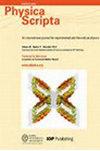Effective and efficient coded aperture cone-beam computed tomography via generative adversarial U-Net
IF 2.6
3区 物理与天体物理
Q2 PHYSICS, MULTIDISCIPLINARY
引用次数: 0
Abstract
Coded aperture cone-beam computed tomography (CBCT) represents a crucial method for acquiring high-fidelity three-dimensional (3D) tomographic images while reducing radiation exposure. However, projections are non-uniformly and discontinuously sampled with the coded apertures placed in front of the x-ray source, leading to very small reconstruction scale and time-intensive iterations. In this study, an alternative approach to reconstruct coded aperture CBCT based on generative adversarial U-net is proposed to effectively and efficiently reconstruct large scale 3D CBCT images. Our method entails predicting complete and uniform projections from incomplete and non-uniform coded projections, enabling the requirement of continuity for the use of analytical algorithms in 3D image reconstruction. This novel technique effectively mitigates the traditional trade-off between image fidelity and computational complexity inherent in conventional coded aperture CBCT reconstruction methods. Our experimental results, conducted using clinical datasets comprising CBCT images from 102 patients at Nanjing Medical University, demonstrate that high-quality CBCT images with voxel dimensions of 400 × 400 × 400 can be reconstructed within 35 s, even when 95% of projections are blocked, yielding images with PSNR values exceeding 25dB and SSIM values surpassing 0.85.通过生成式对抗 U-Net 实现有效和高效的编码孔径锥束计算机断层扫描
编码孔锥束计算机断层扫描(CBCT)是获取高保真三维(3D)断层图像的重要方法,同时还能减少辐射暴露。然而,由于在 X 射线源前面放置了编码孔,因此投影采样不均匀、不连续,导致重建尺度非常小,迭代耗时。本研究提出了一种基于生成对抗 U 网的编码孔径 CBCT 重构替代方法,可高效重建大规模三维 CBCT 图像。我们的方法需要从不完整和不均匀的编码投影中预测完整和均匀的投影,从而满足在三维图像重建中使用分析算法的连续性要求。这项新技术有效地缓解了传统编码孔径 CBCT 重建方法固有的图像保真度和计算复杂性之间的传统权衡问题。我们使用南京医科大学 102 名患者的 CBCT 图像组成的临床数据集进行的实验结果表明,即使 95% 的投影被阻断,也能在 35 秒内重建体素尺寸为 400 × 400 × 400 的高质量 CBCT 图像,图像的 PSNR 值超过 25dB,SSIM 值超过 0.85。
本文章由计算机程序翻译,如有差异,请以英文原文为准。
求助全文
约1分钟内获得全文
求助全文
来源期刊

Physica Scripta
物理-物理:综合
CiteScore
3.70
自引率
3.40%
发文量
782
审稿时长
4.5 months
期刊介绍:
Physica Scripta is an international journal for original research in any branch of experimental and theoretical physics. Articles will be considered in any of the following topics, and interdisciplinary topics involving physics are also welcomed:
-Atomic, molecular and optical physics-
Plasma physics-
Condensed matter physics-
Mathematical physics-
Astrophysics-
High energy physics-
Nuclear physics-
Nonlinear physics.
The journal aims to increase the visibility and accessibility of research to the wider physical sciences community. Articles on topics of broad interest are encouraged and submissions in more specialist fields should endeavour to include reference to the wider context of their research in the introduction.
 求助内容:
求助内容: 应助结果提醒方式:
应助结果提醒方式:


